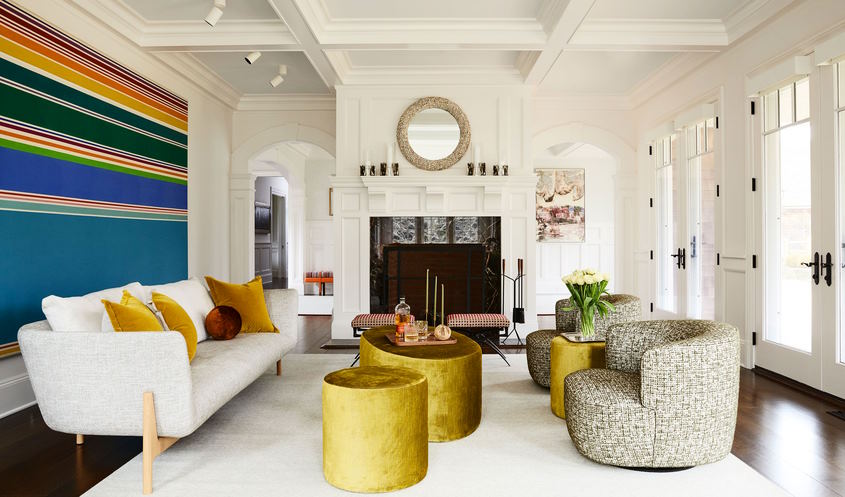The Art of Mixing Patterns: How to Create Stylish Interiors
Patterns have long been a key element in interior design, adding depth, personality, and visual interest to any space. While using one or two patterns in a room can be a safe and straightforward approach, mixing patterns can elevate a design to a whole new level. The art of combining different patterns can be intimidating, but when done correctly, it can create a cohesive and stylish look that reflects the homeowner’s unique personality and style. We will explore the art of mixing patterns in interior design, discussing the principles, benefits, and common mistakes to avoid when incorporating patterns into your home décor. Whether you’re a maximalist or a minimalist, this guide will provide inspiration and practical tips for creating a stylish and harmonious space with the power of patterns.

Principles of Mixing Patterns
Mixing patterns in interior design is an art that requires careful consideration and thoughtful execution. To create a harmonious and visually appealing space, it’s important to keep some key principles in mind.
- Selecting a Dominant Pattern: One of the fundamental principles of mixing patterns is to choose a dominant pattern that serves as the focal point of the room. This pattern will set the tone for the overall design and act as a guide for selecting other patterns. It could be a bold floral wallpaper, a vibrant geometric rug, or an eye-catching striped accent wall. By starting with a dominant pattern, you can build around it and create a cohesive look that ties all the patterns together.
- Creating Contrast and Balance: When mixing patterns, it’s essential to create contrast and balance. Combining patterns with complementary colors, scales, and textures can add visual interest and depth to a space. For instance, if your dominant pattern is a large-scale floral, you can balance it with smaller-scale stripes or geometrics in complementary colors. Additionally, contrasting textures, such as a smooth velvet against a rough burlap, can add tactile appeal to the design. Strive for a balance between bold and subtle patterns, ensuring that they complement and enhance each other.
- Starting Small and Gradually Increasing Complexity: Mixing patterns can be overwhelming, especially for those who are new to interior design. A helpful tip is to start small and gradually increase the complexity of patterns in a space. Begin with one or two patterns and experiment with different combinations to see what works best. As you gain confidence, you can gradually introduce more patterns into the room, paying attention to the scale, color, and texture relationships. This approach allows you to refine and edit the design as you go, ensuring that the patterns work harmoniously together without overwhelming the space.
Applying Mixing Patterns in Different Areas
Mixing patterns can elevate the style of any room in your home, from the living room to the bedroom, dining room, and even the bathroom. Here are some ideas on how to effectively mix patterns in different areas of your home, along with tips on choosing patterns for different elements and using patterns in unexpected ways.
- Living Rooms: The living room is often the heart of the home, and it’s a great place to experiment with mixing patterns. Start with a dominant pattern on a focal point, such as a large area rug or statement wallpaper. Then, layer in smaller-scale patterns on throw pillows, accent chairs, and curtains. Consider mixing florals with stripes, geometrics with abstracts, or even animal prints with plaids. Remember to balance the color, scale, and texture of the patterns to create a cohesive and visually appealing look.
- Bedrooms: Bedrooms are perfect for creating cozy and inviting spaces with mixed patterns. Consider using patterns on bedding, headboards, and accent walls. Play with different scales and textures, such as combining a large-scale floral comforter with small-scale polka dot pillows. Keep the color palette consistent for a cohesive look, and consider layering in patterns on accessories like lamps, rugs, or even artwork.
- Dining Rooms: Dining rooms provide an opportunity to add drama and personality with mixed patterns. Consider using patterns on dining chairs, tablecloths, and curtains. Mix different types of patterns, such as stripes with damasks, or checks with florals, to create a visually interesting and dynamic space. Consider using patterns with complementary colors to create a harmonious look, and keep the scale of the patterns in mind to ensure they work well together.
- Bathrooms: Bathrooms are not to be overlooked when it comes to mixing patterns. Consider using patterns on shower curtains, floor tiles, and wallpaper. You can play with different textures, such as combining a geometric patterned shower curtain with a mosaic tile floor. Remember to keep the color palette cohesive, and consider using patterns that are suitable for humid environments.
- Considerations for Choosing Patterns: When choosing patterns for different elements in your home, consider the scale of the patterns in relation to the size of the room and the other patterns in the space. Larger patterns may work well on larger pieces of furniture, such as sofas or area rugs, while smaller patterns may be better suited for smaller elements like throw pillows or lampshades. Consider the color palette of the patterns and how they will work with the overall color scheme of the room. It’s also important to consider the texture of the patterns and how they will interact with other textures in the space.
- Unexpected Uses of Patterns: Don’t be afraid to get creative with patterns in unexpected ways. Consider using patterns on ceilings to add a touch of drama to a room, or on backsplashes in kitchens or bathrooms for a unique and eye-catching look. You can even use patterns on statement pieces of furniture, such as accent chairs, ottomans, or even a patterned headboard. Mixing patterns in unexpected ways can add a touch of personality and flair to your home’s design.



